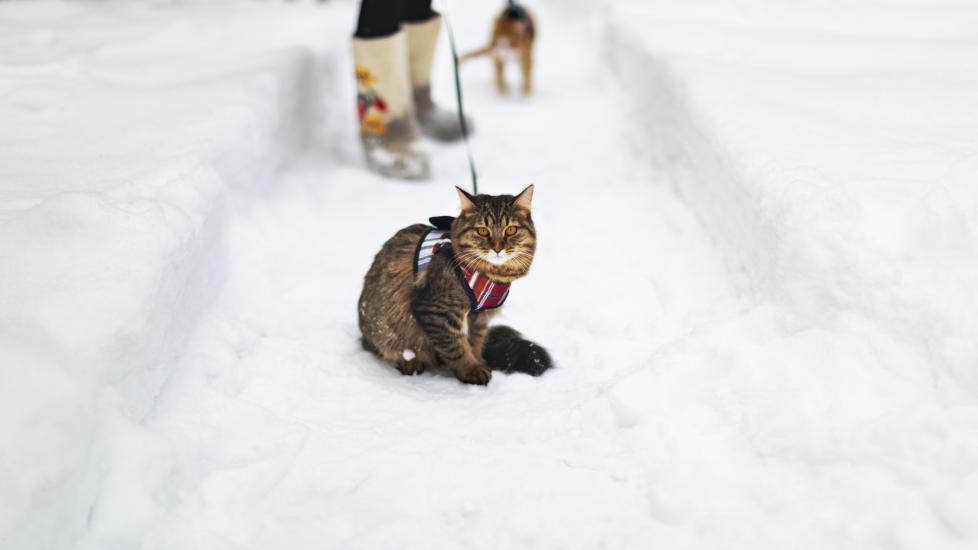Hypothermia in Cats
What Is Hypothermia in Cats?
Cats run a little hotter than we do, with a normal body temperature of 100 degrees F to 102.5 degrees F. Hypothermia in cats is when their body temperature falls below normal, or under 100 degrees F.
With mild hypothermia, a cat’s blood pressure, respiratory rate, and heart rate initially increase. However, as hypothermia progresses, all three decreases. Lack of adequate blood flow and oxygen can lead to heart arrhythmias and, in severe cases, death.
You may not readily notice mild hypothermia. If your cat is shivering, it means their body is actively working to combat hypothermia.
However, if your cat is cold to the touch and acting excessively tired, or if your cat isn’t responsive, this is an emergency. Take your cat to the nearest emergency veterinarian.
Hypothermia is more common in kittens, senior cats, and cats who go outdoors. A cat of any breed can develop hypothermia, though healthy cats usually don’t develop this condition.
Symptoms of Hypothermia in Cats
You may have an image in your mind of what a person with hypothermia looks like. Well, some of the same symptoms occur in cats.
Symptoms of hypothermia in cats include:
-
Collapse or coma
-
Being cold to the touch
-
Fast breathing with mild hypothermia and slow breathing with severe hypothermia
-
Low blood pressure (detected by a veterinarian)
-
Abnormal heart rhythms (detected by a veterinarian)
Causes of Hypothermia in Cats
There are several circumstances that can lead to hypothermia in cats, including:
-
Exposure to freezing temperatures, especially wet and windy conditions
-
Recovering from or undergoing an anesthetic procedure
-
Medical conditions like heart disease, kidney disease, or sepsis
-
Head trauma
How Veterinarians Diagnose Hypothermia in Cats
To diagnose hypothermia in cats, your veterinarian will simply take your cat’s temperature. Insertion of the thermometer into the rectum is the preferred method.
Providing your veterinarian with your cat’s recent activities and relevant medical history is crucial for making an appropriate diagnosis of the cause of the hypothermia. You can help your veterinarian by sharing any of the following information:
-
Has your cat been outside recently?
-
Was your cat bathed recently?
-
Does your cat have any known medical conditions, particularly heart disease, kidney disease, or a recent infection?
The veterinarian will run several lab tests to monitor your cat’s overall health. They will want to rule out anemia and make sure your cat’s blood sugar level is normal. They may also perform an electrocardiogram (ECG), which is a test that allows your vet to look at your cat’s heart rhythm.
If there is concern about other medical conditions like heart disease, additional tests such as an echocardiogram (ultrasound of the heart) may be recommended.
Treatment of Hypothermia in Cats
The primary goal of treating hypothermia is to get your cat’s body temperature back to normal.
Several methods exist for rewarming your cat. External rewarming includes wrapping your cat in blankets, applying warm water bags, and using heating pads or other warming devices like Bair Huggers™. Warming devices should always be separated from the cat by towels or blankets to prevent burns.
In severe cases, internal rewarming may be performed. This involves putting warmed fluid into a cat’s stomach, rectum, or abdomen. IV fluids will also be warmed prior to administration. Internal rewarming should only be performed by veterinary staff. Cats with hypothermia due to severe heart disease may not be given IV fluids because it could overload their heart.
Abnormal heart rhythms in hypothermic cats don’t generally respond well to the medications that veterinarians would otherwise use to treat them. These arrhythmias generally improve on their own as body temperature increases. The veterinarian will keep an ECG on a cat to monitor their heart rhythm during recovery.
Unconscious patients may need to have a tube placed in their trachea to help them breathe and to prevent aspiration if they vomit. Supplemental oxygen can be administered through this endotracheal tube.
Recovery and Management of Hypothermia in Cats
Cats who are going to recover will usually return to their normal body temperature within several hours. In moderate to severe cases, your veterinarian may want to keep your cat in the hospital for a day or two to monitor their recovery.
If your cat has an underlying health condition like heart disease contributing to their hypothermia, lifelong management will be necessary. Your veterinarian will work with you to develop the best management plan for your pet.
In some severe cases, the damage is too severe and the cat will not recover. Cats who have hypothermia due to exposure to freezing temperatures should also be checked for frostbite.
Heated beds may help keep your cat comfortable at home. Be cognizant that some heated beds come with cords that are chewing hazards, and others present burn risks if your cat uses them unmonitored. Make sure to follow any safety recommendations and instructions that are provided when you purchase a heated bed.
Prevention of Hypothermia in Cats
To prevent hypothermia in cats, the best thing pet parents can do is keep their cats indoors. If your cat must go outside, ensure you are providing a shelter away from wind and precipitation.
We also recommend regular veterinary wellness appointments to monitor for predisposing health conditions.
Featured Image: JulPo/E+ via Getty Images
